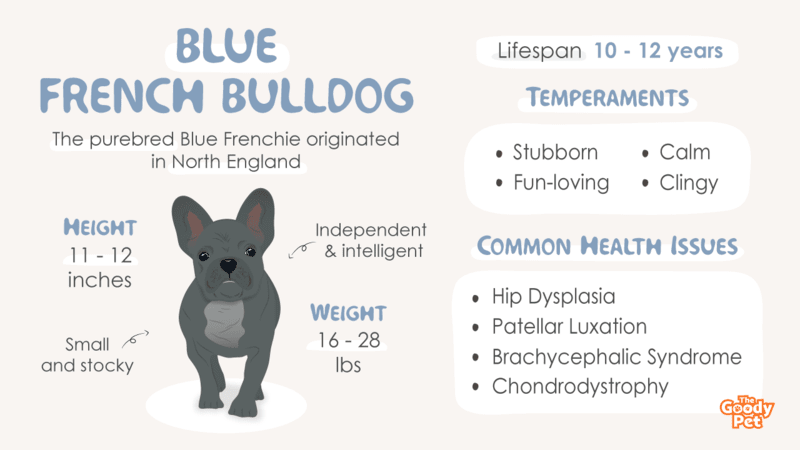The Blue French Bulldog is an eye-catching dog breed with a unique appearance. Its glorious fur coat is not to be ignored. So, what is a Blue French Bulldog, and how much do you know about this little dynamite package?
Blue Frenchies are French bulldogs who possess different color variations. There are several color variations of the French bulldog, such as the Blue Merle, Blue Fawn, Blue Pied, and the Blue Brindle French Bulldog. Blue Frenchies are small and stocky, making them ideal apartment pets. These round-faced and stocky dogs were originally bred for companionship with their owners. The Blue Frenchie is a laid-back and social breed, making the Blue Frenchie an ideal family dog.
The Blue French Bulldog’s facial structure makes them quite susceptible to several health issues. Blue Frenchies are challenging to train, but once you have trained them, they are reliable and loyal to you.
Are Blue Frenchies Purebred?
Origins And History
The purebred Blue Frenchie originated in North England and was bred to be a smaller version of the bulldog. The small Blue French Bulldog was commonly liked by lacemakers in England.
When the lace makers moved to France for greater opportunity in the lace-making industry, they took their dogs. The French Bulldog wasted no time in catching the attention of the French.
They quickly became popular in Europe and were first seen in the United States in 1896, at the Kennel Show. The Blue Frenchie promptly received the name ‘Blue French Bulldog’ not long after. According to AKC, the Blue French Bulldog is the second most popular dog breed.
Size
A Blue French Bulldog is typically between 11 to 12 inches in height. Male Blue Frenchies weigh approximately 20 to 28 lbs, while female Blue Frenchies weigh about 16 to 24 lbs.
Appearance
The Blue Frenchie has quite a unique appearance. They have flat faces with point-bat-like ears. Their ears are generally always pricked, giving the Blue Frenchie an attentive look. Blue French Bulldogs are naturally small, but many of them are affected by a form of dwarfism.
This form of dwarfism is called chondrodystrophy. This condition results in even smaller Blue French Bulldogs with oversized heads, compared to the rest of their bodies. Blue Frenchies also have small stocky frames with short tails.
What Color And Patterns Do Blue Frenchies Have?
The color variations of the Blue French Bulldog are a result of a relatively rare recessive gene. This recessive gene is known as the dilution gene.
When a French Bulldog possesses a pair of this gene, then the French Bulldog’s fur coat will be blue and comes in variations as covered below.
Blue Merle French Bulldog
The Blue Merle is a beautiful color that is challenging to breed and rare to come across. To achieve a Blue Merle French Bulldog, you would have to mate a Blue Merle French Bulldog and a Blue French Bulldog. This mating combination results in a blue patchy fur coat.
The patches are a result of the dominant Blue Merle genes. The size, location, and pattern of the patches differ from dog to dog.
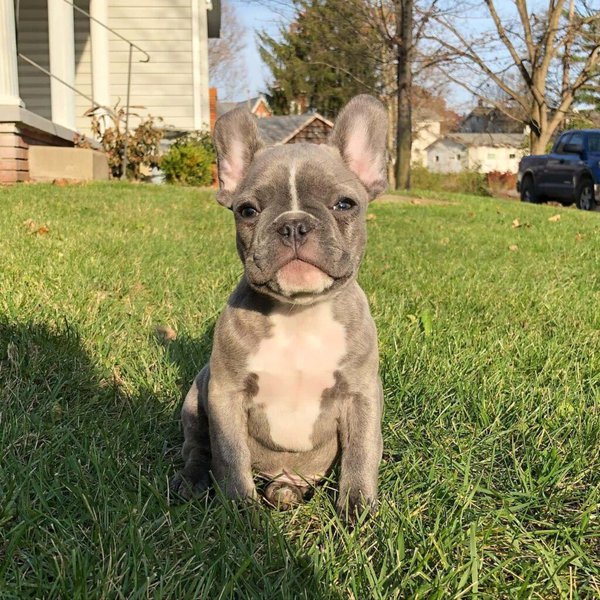
Blue Fawn French Bulldog
The Blue Fawn carries the same double genes as the Blue and Pied French Bulldogs however, their Fawn color results from two additional genes that they carry. The dark blue color on the Fawn Frenchie possesses a brindle gene.
The brindle gene can be seen around the Fawn Frenchie’s ears, back, eyes, and muzzle. The unorthodox color combination displayed by the Fawn Frenchies, makes them widely sought after.
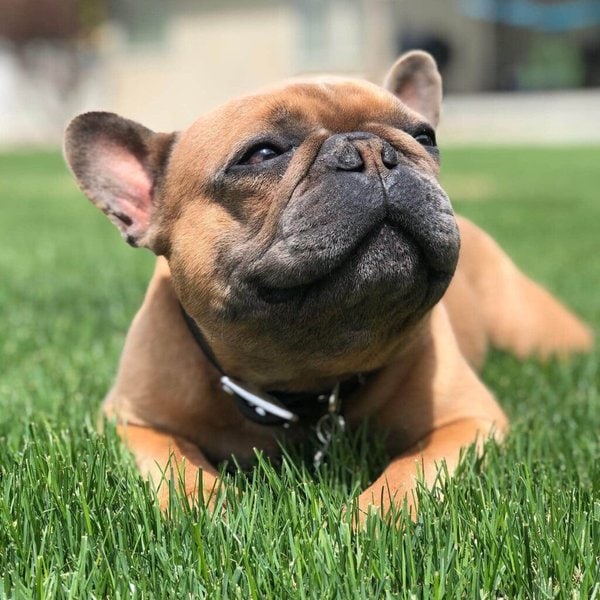
Pied
The Blue Pied Frenchie is the easiest to breed. The difficulty comes in when trying to predict the pattern and breed them to achieve a specific pattern. You can breed a Blue Pied Frenchie by mating a Blue Frenchie with a Pied Frenchie.
The Pied pattern is recessive when compared to solid colors. Pied Frenchies have lighter fur on their cheeks, legs, and chests.
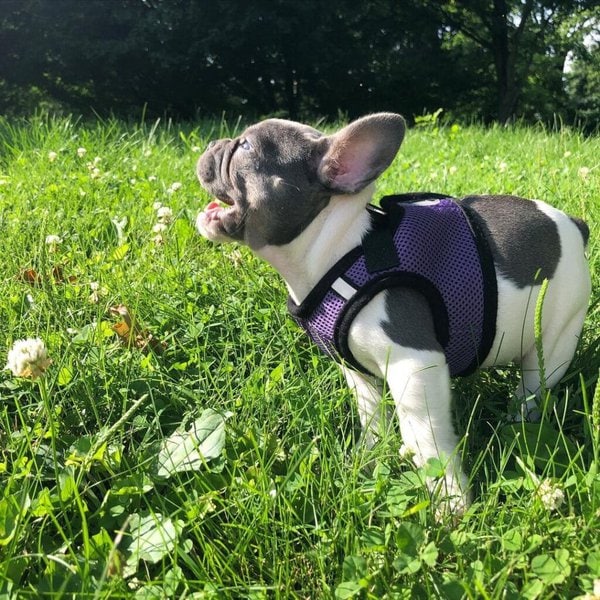
Blue Brindle French Bulldog
The Blue Brindle Frenchie possesses a slightly gray or blue fur coat. They may have strips or brindle markings appearing on the Brindle Frenchie’s fur when they are puppies. The eye color may be brown, blue, gray, or yellow.
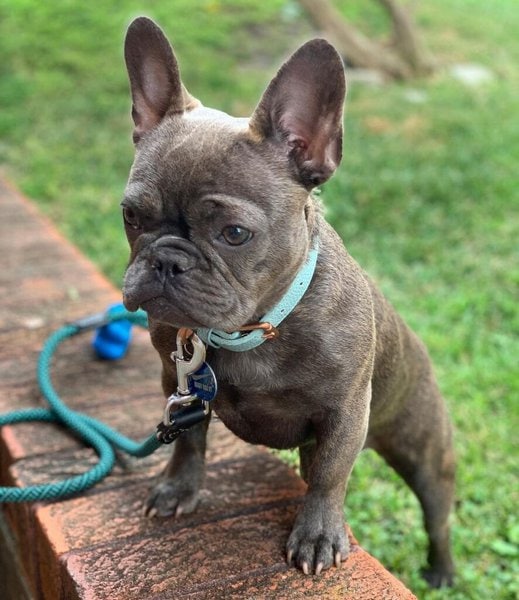
What’s Wrong With Blue French Bulldogs?
The Blue French Bulldog is prone to several health issues and physical restrictions because of their body structure. Some of the health issues that they may face are hip dysplasia, patellar luxation, brachycephalic syndrome, and chondrodystrophy.
Breeding
When trying to breed a Blue Frenchie, you should make sure that both parents are completely healthy and that they do not possess a faulty version of the dl, which is the d allele. The faulty dl causes a condition known as color dilution alopecia.
When both parents carry the rare dilute gene, then it is highly probable that their puppies will end up with blue fur coats. The exact color of the puppies’ fur coats may range from black, gray, and blue. Blue Frenchies typically have charming and vivid blue eyes.
A Blue Frenchie can be expected to live for approximately 10 to 12 years. This life expectancy is according to AKC.
Here are some of the common health issues these dogs may have:
Hip Dysplasia
Hip dysplasia is a common orthopedic condition in Blue French Bulldogs. It is a heritable condition caused by a malformed hip joint. More specifically, hip dysplasia is the result of your Blue Frenchie’s femur not adequately fitting into its pelvic socket.
It can and will affect one or both of your Blue Frenchie’s hips, leading to lame hindlegs. If hip dysplasia is not treated, it can cause arthritis, bone spurs, and erosion of cartilage. Symptoms of hip dysplasia include:
- Drastic decrease in activity level
- Limping
- Loss of thigh muscles
- Lameness in hind legs
Patellar Luxation
Patellar luxation is a condition that commonly manifests in small dogs. It is also referred to as ‘Slipped Stifles’. This condition is caused when the patella is not lined properly, resulting in it moving in and out of place.
The constant movement of the patella results in lameness and unusual mobility. Patellar luxation is a condition that presents itself at birth. However, the patella movement may occur later in your Blue Frenchie’s life. Symptoms of patellar luxation include:
- Movement of the kneecap to the side
- Locking of the knee
- Popping of the knee
- Inflammation in the knee
Brachycephalic Syndrome
Brachycephalic syndrome is commonly found in dogs with short heads, soft palates, and narrow nostrils, causing their airways to be obstructed and limited to different degrees. The airway obstruction can result in difficulty breathing or the failure of your Blue Frenchie’s airway.
Blue French Bulldogs who are affected by this syndrome often snore and snort. Symptoms of brachycephalic syndrome include:
- Excessively loud breathing
- Difficulty breathing while exercising
- Fainting
- Gagging while swallowing
Chondrodystrophy
This is a form of Dwarfism that many Frenchies suffer from. It results in features that are widely sought after by numerous breeders. However, this desirable appearance does not come without a price.
Chondrodystrophy can cause back problems, hip deformities, and heads that are oversized when compared to the Frenchie’s body. The oversized heads, along with narrow pelvises, prevent many Blue French Bulldogs from being able to have natural births.
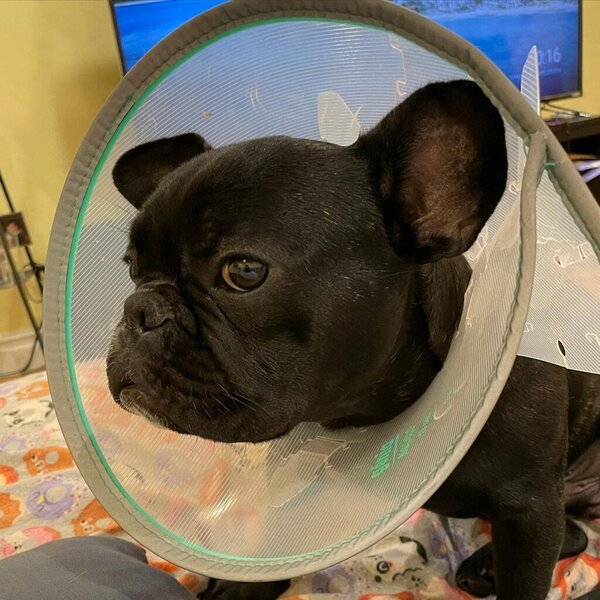
How To Take Care Of Blue French Bulldogs?
The Blue Frenchie is ultimately a disabled dog due to the brachycephalic syndrome. Like most disabled dogs, these Frenchies have special needs and require more attention than regular dogs.
You can care for them by ensuring that your Blue Frenchie has a well-balanced diet and amount of exercise.
Diet
Blue French Bulldogs are generally an inactive dog breed who prefer lounging around, instead of being overly active. You need to ensure that your Blue Frenchie does not overeat and becomes obese. Obesity will worsen or cause health issues that they are susceptible to.
If your Blue Frenchie is too heavy, their joints will become strained, and this will worsen any joint condition that your Blue French Bulldog may already have. Obesity can also worsen/cause respiratory health issues.
It is not enough to ensure that your Blue Frenchie does not overeat, you also have to ensure that they eat enough of the correct food. We would suggest feeding your Blue Frenchie high-quality dog food that includes essential nutrients like dog meals from Pet Plate.
You should also ensure that you incorporate multivitamins and healthy supplements into your Blue Frenchie meals. Omega-3 fatty acid supplements are crucial for Blue Frenchies. These supplements support the joints and lubricate them while boosting your dog’s immune system.
Physical Activity
Blue French Bulldogs are susceptible to several joint and respiratory health issues. These health issues can be worsened by over-exercising and obesity. Your Blue Frenchie must exercise enough to maintain a healthy weight. Your Blue Frenchie should not exceed 28 lbs.
Physical activity should not only be viewed as a way to maintain your Blue Frenchie’s weight, but you should also enjoy playing with your dog. Blue Frenchies are joyous and loyal dogs, they thoroughly enjoy spending time with their owners.
However, all good things should be moderate. If your Blue Frenchie exercises excessively, it will collapse. Their incredibly short muzzles and narrow nostrils do not allow for much airflow, so they struggle to get enough oxygen when they exercise.
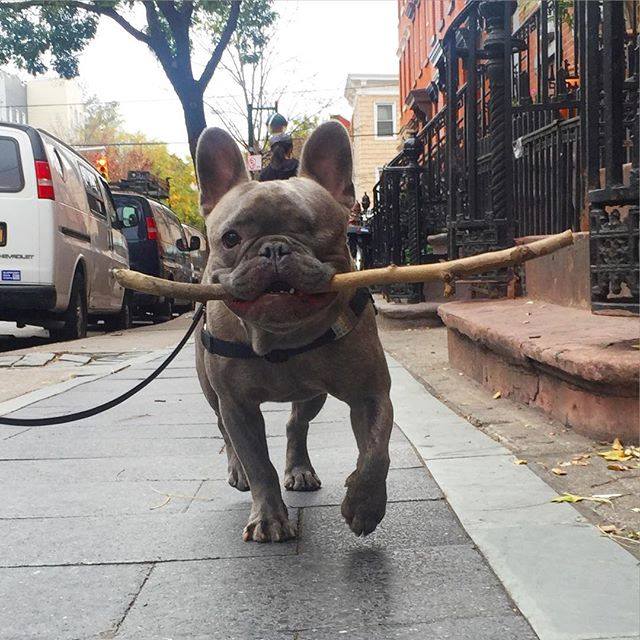
Why Are Blue French Bulldogs So Hard To Train? Temperaments Of Blue French Bulldogs
Trainability
Although Blue Frenchies are independent, intelligent, and have a profound need to please, they are also quite stubborn, making them challenging to train. As is the case with many dogs, you should start training from an early age.
You can start training your Blue French Bulldog as early as when they are eight weeks old. There are several training methods available to dog owners. Every dog is unique, so you should try various approaches to training your Blue Frenchie.
Temperament
Blue Frenchies are calm and fun-loving dogs. Blue French Bulldogs are a playful and attentive breed who loves company. They were bred for companionship, so they can be quite clingy.
Blue French Bulldogs are social and adaptable. They enjoy playing games such as fetch and calm activities such as walks. When excited, Blue Frenchies can be quite destructive, which can be expected because of their roughhousing trait inherited from the English Bulldog.
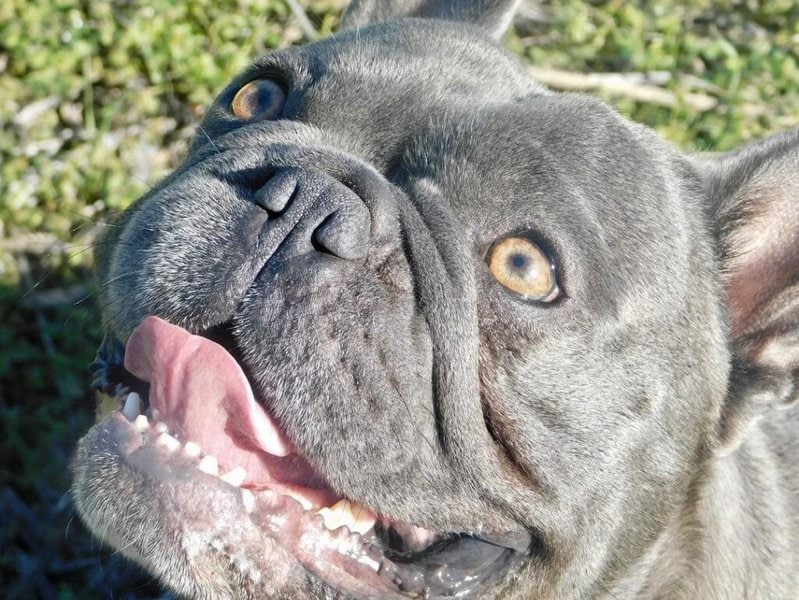
Do Blue Frenchies Shed? Grooming Tips For Blue French Bulldogs
Grooming Tips
Blue French Bulldogs are relatively easy to groom. They require a good brushing session occasionally, to keep their fur coat healthy. In terms of the amount of shedding that they experience, they are in the middle of the spectrum.
Regular Brushing
Blue Frenchies have several folds/wrinkles all over their bodies. When you Groom your Blue Frenchie, ensure that the folds are free of dirt, scabs, flaky skin, or any signs of infections.
We suggest using the FURminator Undercoat Tool to effectively remove loose hair without cutting your dog. This tool would especially be helpful for a Blue Frenchie because of the many folds. You should still exercise caution when using this tool on your Blue Frenchie.
Clean Ears
You should use a damp warm cloth and cotton swab to clean your Blue Frenchie’s ears. You should never insert the swab directly into the ear canal, if you are unsure of yourself, you should consult a professional rather than running the risk of harming your Blue Frenchie.
Trim Nails Regularly
To avoid splitting and other nail-related injuries, you should ensure that your Blue Frenchie’s nails are trimmed regularly.
Bathe As Regularly As Necessary
Blue Frenchies are susceptible to infections and dry skin because of their wrinkles and skin folds, so you should ensure that you bathe your Blue French Bulldog as often as necessary.
To ensure that your Blue Frenchie’s fur coat gets the attention that it requires, we suggest using the Mighty Petz 2-in-1 Oatmeal Dog Shampoo and Conditioner.
Related Questions
How Much Do Blue French Bulldogs Cost? The cost of a healthy Blue French Bulldog puppy can range between $1,500 and $10,000. Blue Frenchies are expensive because they are quite challenging to breed. After all, the breeders have to locate perfectly healthy Blue Frenchie parents. These Frenchies also require special mating and birth-giving treatment because of their short hips and bodies.
Do Blue Frenchies Eyes Stay Blue? Blue Frenchie puppies all have dazzling blue eyes. As your Blue French Bulldog grows, its eyes will, however, no longer stay blue. Your Blue Frenchie’s eyes will typically change color when they are about ten weeks old.
What Is A Blue Merle Frenchie? A Blue Merle Frenchie is a color variation of the Blue French Bulldog. It is a black Frenchie that has a diluted base color, resulting in a blue hue.

